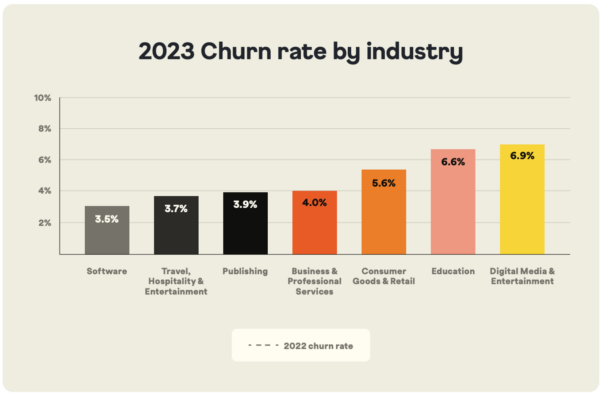The percentage of customers who cancel their subscriptions within a given period is a key metric that reflects your company’s ability to satisfy and retain customers. Understanding and managing that SaaS churn rate is critical to scaling your company. A high churn rate means you’re losing valuable customers, which translates directly into lost revenue and missed opportunities for upselling or cross-selling. Conversely, a low churn rate is a sign of a healthy, thriving business with satisfied customers who are more likely to become advocates for your brand. Knowing your industry’s SaaS churn rate benchmark gives you a valuable reference point that will help you not only compare your churn rate to internal KPIs, but to gauge your performance against competitors as well. If your churn rate is higher than the benchmark, it may signal underlying issues that need addressing.
Understand how you measure up and take proactive steps to drive sustainable growth by retaining more customers.
Take a Deep Dive with Us
- What’s an Acceptable Annual SaaS Churn Rate Benchmark?
- How to Calculate SaaS Churn Rate
- Why Does Customer Churn Occur?
- Use the SaaS Churn Rate Benchmark to Improve Financial Health
- Actionable Strategies to Lower Your SaaS Churn Rate
- Beyond Customer Loss: Understanding Other Kinds of Churn
- Manage SaaS Churn and Scale Your Company
What’s an Acceptable Annual SaaS Churn Rate Benchmark?
While calculating KPIs like churn rate is important, you’ll gain deeper insight by comparing your results to industry benchmarks. Using benchmarks allows you to contextualize your churn rate, identify trends, and set realistic goals for improvement. It also helps you recognize when you’re outperforming the market, a strong indicator of competitive advantage.
Like other SaaS marketing benchmarks, the SaaS churn rate benchmark offers a point of reference to assess how your company is performing relative to competitors. If your churn rate is higher than the industry average, it may indicate underlying issues that need to be addressed, such as product-market fit, customer support, or pricing strategies.
Industry experts diverge in their estimation of where to place the SaaS churn rate benchmark. Some set a goal as low as 2%, while others suggest a rate above 10%. After in-depth research, the 2024 State of Subscriptions Report from subscription management platform Recurly found that churn rates for software providers was 3.5% and that the figure hovered at 5.57% across all industries. Keep in mind that established enterprises will typically find themselves on the lower end of this range, and SMBs on the higher side. Startups may see churn rates well outside of these figures while they find the right users for their products.
Achieving and sustaining a churn rate between Recurly’s two stats will set your SaaS up for long-term growth by allowing you to:
- Assess performance: See how you stack up against competitors.
- Identify trends: Spot potential red flags in your customer retention strategy.
- Set realistic goals: Establish achievable targets for improvement.
- Recognize success: Celebrate when you’re outperforming the market.
How to Calculate SaaS Churn Rate
Calculating your SaaS churn rate will help you understand more about which parts of your customer retention strategy are working and which are not, as well as to identify areas for improvement. The formula is rather straightforward:

If you started the month with 1,000 customers and ended with 950 customers, the calculation would be:

This means you have a 5% churn rate for that month.
Monthly vs. Annual Churn
Churn metrics can vary significantly depending on whether you measure them monthly or annually. Monthly churn provides a snapshot of short-term performance, allowing you to track immediate trends and react swiftly. Annual churn, on the other hand, gives a more comprehensive view of long-term customer retention and revenue sustainability.
For example, a 1% monthly churn rate may seem manageable at first glance. However, when extrapolated over a year, the cumulative churn becomes significant:

Using this formula, a 1% monthly churn rate translates to an annual churn rate of approximately 11.3%. Comparing both metrics to the SaaS churn rate benchmark can help you identify patterns that may not be immediately apparent.
Why Does Customer Churn Occur?
Involuntary churn happens when customers lose access to your service due to failed payments or billing issues. These cases are often unintentional and can be mitigated by using tools like dunning management systems, which automate reminders, retries, and other recovery efforts. Proactively addressing involuntary churn helps to recover lost revenue and maintain customer relationships without requiring significant intervention.
Voluntary churn, on the other hand, occurs when customers actively cancel their subscriptions, often due to dissatisfaction with the product or a lack of perceived value. This type of churn is typically a direct reflection of your customers’ experience and satisfaction with your offering. Addressing voluntary churn requires understanding the root causes, such as misaligned expectations, limited product utility, or inadequate customer support, and taking corrective action.
Uncovering the specific causes of your company’s SaaS churn is essential to creating effective mitigation strategies. There are many ways for you to gain the insights you need:
1. Analyze Customer Feedback: Regularly conduct customer satisfaction surveys to gauge how your customers feel about your product. Look for patterns in the feedback that might be contributing to churn.
2. Monitor Product Usage Patterns: Dive into your product analytics to monitor how customers are using (or not using) your product. Identify usage patterns to pinpoint where customers might be losing interest or encountering difficulties. Leverage what you learn to improve the product experience.
3. Segment Your Churned Customers: Not all customers churn for the same reasons. Segmenting your churned customers based on characteristics such as industry, company size, or usage patterns can reveal different churn drivers across different customer groups.
4. Conduct Exit Interviews: Whenever possible, reach out to customers who have decided to cancel their subscriptions. While not every customer will be willing to share their reasons, those who do can offer valuable perspectives.
5. Analyze Support Tickets and Customer Interactions: Your customer support team is on the front lines, often dealing with frustrated or dissatisfied customers. Examine their notes for trends in the types of problems customers are reporting and for common themes in their complaints.
6. Benchmark Against Competitors: Keep an eye on your competitors to understand if and why customers might be leaving for greener pastures. This competitive analysis can also inform your product development and marketing strategies, helping you to better meet customer needs.
7. Leverage Predictive Analytics: Advanced analytics tools can help you predict which customers are at risk of churning before they leave. By identifying key indicators of potential churn, these modern technologies help you take proactive steps to re-engage these customers before it’s too late.
8. Monitor Social Media and Online Reviews: Watch social media platforms and online review sites for customer feedback that might not surface through more direct channels. Take note of recurring complaints or issues that might signal broader dissatisfaction.
Use the SaaS Churn Rate Benchmark to Improve Financial Health
Churn is a window into the overall health of your business. Your SaaS churn rate directly impacts other critical KPIs, making it an essential metric for any SaaS company to monitor closely. For example, when you know how to calculate LTV, you can use that figure to determine the total revenue your company expects to earn from a customer over the entire duration of each relationship. However, when customers leave sooner than expected, the revenue they generate is cut short. That churn has a ripple effect on your overall financial performance. Monitoring your churn rate helps you understand the longevity of your customer relationships and the long-term value each customer brings to your company. If your churn rate is high, it’s a sign that you may be losing revenue opportunities that could otherwise fuel growth.
Insights related to the SaaS churn rate benchmark should be incorporated into key strategic decisions:
- Product Development: A high churn rate suggests that your product isn’t fully meeting customer needs. Analyze and understand why customers are leaving, so that you can prioritize features or improvements that address these gaps. The end result will be a more robust and appealing product that generates higher revenue.
- Pricing: If customers feel they’re not getting enough value for the cost, your churn rate may be tied to pricing. Understand this relationship to reduce churn by better aligning your B2B SaaS pricing strategy with customer expectations.
- Customer Segments: Focus on high-value customer segments that align most closely with your ideal customer profile (ICP). These customers typically demonstrate the highest lifetime value and the lowest churn propensity. Target these segments with tailored messaging, support, and product enhancements to maximize retention and revenue growth.
- Customer Retention: Numerous studies have proven that it is more cost-effective to retain customers than to acquire new ones. Focus on the factors that drive churn to develop personalized engagement, loyalty programs, enhanced customer support, and other targeted retention strategies. These will keep your customers satisfied and reduce turnover.
Actionable Strategies to Lower Your SaaS Churn Rate
The good news for SaaS leaders is that there are concrete steps you can take to improve an unacceptable SaaS churn rate. Focus on customer satisfaction, engagement, and value delivery, to create a user-centric experience, maximize long-term growth and meet or beat the SaaS churn rate benchmark.
Small changes can have a big impact, so start where it matters most and continuously refine your approach. Here are ten proven strategies you can implement today:
1. Improve Customer Onboarding: The onboarding process sets the tone for the entire customer experience. Adopt SaaS onboarding best practices to ensure new users are guided through product features, use cases, and best practices in a seamless, engaging way. Leverage interactive tutorials, webinars, and onboarding emails to make the learning curve as smooth as possible.
2. Enhance Product Features: Continuously improve your product based on user needs and industry trends. Regular updates and feature enhancements show your commitment to delivering value. Pay particular attention to data security and integrity, currently a high priority for many users. Consider hosting beta programs to gather feedback before full rollouts.
3. Personalization: Tailor product experience to meet the unique needs of individual users or customer segments. This could include customized dashboards, personalized recommendations, or usage-driven notifications.
4. Offer Outstanding Customer Support: Exceptional customer support can turn dissatisfied users into loyal advocates. Provide multiple support channels such as live chat, email, and a knowledge base, and ensure fast, helpful responses.
5. Offer Periodic Free Trials for Higher-Tier Plans: Allow existing customers to test higher-tier plans for free to provide them with a risk-free opportunity to experience additional value. These trials often encourage upgrades, deepening customer reliance on your platform and reducing churn risk.
6. Incentivize Longer-Term Contracts: Offer discounts or exclusive benefits to customers who commit to annual or multi-year contracts. Tis stabilize your revenue and fosters a long-term relationship with customers. Clearly communicate the savings and benefits to make these contracts more appealing.
7. Strengthen Communication with Newsletters and Special Announcements: Regular communication keeps your SaaS brand top of mind while reinforcing trust and value perception. Use newsletters and special announcements to share updates, success stories, and tips to maximize product usage.
8. Leverage Gamification and Badges: Gamification makes the product experience enjoyable, increasing stickiness and user satisfaction. Introduce elements such as progress tracking, badges, or rewards for completing key actions. These elements create a sense of achievement and encourage engagement.
9. Monitor Usage Patterns and Engagement to Identify Potential Churn Risks: Use analytics to track user behavior, such as login frequency, feature usage, and inactivity. Early detection of disengagement allows you to proactively address concerns with personalized outreach and other targeted interventions.
10. Establish Feedback Loops for Continuous Improvement: Regularly solicit feedback through surveys, interviews, or in-app prompts to identify pain points and improvement opportunities.
Beyond Customer Loss: Understanding Other Kinds of Churn
While calculating customer churn and comparing it to the SaaS churn benchmark often takes center stage, it’s essential to look beyond this metric to get a full picture of your company’s performance. By broadening your focus to include revenue churn and more, you can gain a deeper understanding of your SaaS business’s health.
These metrics can impact your SaaS business and should be tracked to address challenges and capitalize on growth opportunities:
Revenue Churn
Revenue churn measures the monetary value lost from churned customers and downgraded subscriptions over a given period. Unlike customer churn, which tracks the number of customers who leave, revenue churn highlights the revenue disparity due to lost accounts and downgrades during the same timeframe. Even if your customer churn rate is low, high revenue churn could indicate that you’re losing high-value customers.
To calculate revenue churn, use the following formula:

For example, if you start the month with $50,000 in Monthly Recurring Revenue (MRR) and lose $3,000 from cancellations and $2,000 to downgrades, your revenue churn rate is 10% as follows:

A high revenue churn rate, especially in combination with a customer churn rate above your SaaS churn rate benchmark, can signal deeper issues with customer satisfaction, pricing, or product value.
Net Revenue Retention
While not a direct measure of churn, Net Revenue Retention (NRR) is a critical metric for understanding the balance between lost revenue and gains from upsells or expansions. An NRR above 100% signifies that your company is growing revenue even after accounting for churn, highlighting the effectiveness of cross-selling, upselling, and customer retention strategies. Monitoring NRR alongside other churn metrics provides a well-rounded view of your financial health.
Logo Churn
Logo churn measures the percentage of customers lost during a specific period, regardless of their revenue contribution. This metric is helpful for assessing overall customer retention but does not distinguish between high-value and low-value accounts. It’s a straightforward way to track the volume of churn but can lack the nuance necessary for deeper insights.
Account Churn
Account churn offers a more segmented view by focusing on specific subscription levels or account types. This approach reveals how different customer groups perform, enabling you to identify patterns or challenges unique to certain segments. By comparing account churn with overall churn metrics, you can prioritize strategies that address the most impactful areas of loss.
Manage SaaS Churn and Scale Your Company
Churn impacts your revenue, customer relationships, and overall competitive edge. Understanding and effectively managing your churn rate is critical to the long-term health of your SaaS. Take a proactive approach to identify and address the causes of churn to create a stronger foundation for sustained growth and customer loyalty.
Comparing your churn rate to industry standards is a critical start. The SaaS churn rate benchmark offers a reliable reference point to gauge your company’s performance. If your churn rate is above the benchmark, it signals opportunities to refine your strategies. Implement actionable solutions such as improving onboarding, enhancing product features, and personalizing customer interactions to achieve measurable improvements in retention.
Does managing churn feel like a challenge? You don’t have to tackle it alone. Bay Leaf Digital supports SaaS companies by optimizing key metrics and reducing churn through targeted, data-driven marketing strategies. Contact us today to learn how our specialists can help your business exceed retention benchmarks and drive sustainable growth.






